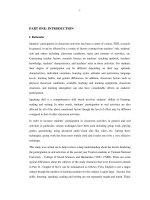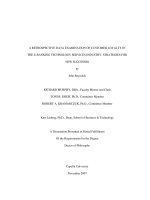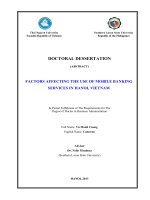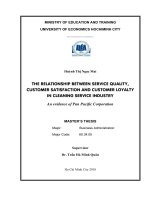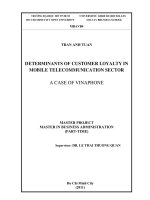factors affecting customer loyalty in mobile communication services in hanoi, vietnam
Bạn đang xem bản rút gọn của tài liệu. Xem và tải ngay bản đầy đủ của tài liệu tại đây (3.41 MB, 174 trang )
FACTORS AFFECTING CUSTOMER LOYALTY IN MOBILE
COMMUNICATION SERVICES IN HANOI, VIETNAM
A RESEARCH DISSERTATION PRESENTED
TO THE FACULTY OF GRADUATE SCHOOL
SOUTHERN LUZON STATE UNIVERSITY LUCBAN, QUEZON, PHILIPPINES
THAI NGUYEN UNIVERSITY S.R. VIETNAM
IN PARTIAL FULFILLMENT OF THE REQUIREMENTS FOR THE DEGREE
DOCTOR IN BUSINESS ADMINISTRATION
Name: Ngo Anh Cuong (Smile)
Thai Nguyen, 2013
i
ACKNOWLEDGMENT
I would like to express our most sincere thanks to the Management Board of the
Southern Luzon State University, Thai Nguyen University, teachers of the school have helped
me facilitate the learning process throughout.
I would like to express sincere gratitude and profound Dr Nelly Mendoza,
enthusiastic teacher who have dedicated guidance, encouragement, spending time and
exchange orientation for me during this research.
I sincerely thank the Board of the University of Labor and Social affair (ULSA),
colleagues in ULSA, classmates DBA1 facilitated enthusiastic help and share my experience
to help complete the dissertation.
Finally, I would like to thank my best friends who have encouraged to complete my
dissertation.
ii
CONTENTS
ACKNOWLEDGMENT i
ABSTRACT v
APPROVAL SHEET xi
Chapter 1: INTRODUCTION 1
1.1 Background of the study 2
1.2 Statement of the problem 3
1.3 Hypotheses 4
1.4. Significance of the study 5
1.5. Scope and limitation 6
1.6 Definition of terms 7
Chapter 2 REVIEW OF RELATED LITERATURES AND STUDIES 10
2.1. Mobile telecommunication services 10
2.2. Hanoi mobile communication services 11
2. 3. Customer loyalty 16
2.4. Affecting factors to loyal customer 18
2.5. Customer loyalty models 29
2.6. Several topics related to mobilecommunication services 31
2.6.1. Some topics researched in Viet Nam 31
2.6.2 Some topics researched Overseas 32
2.7. Conceptual framework 36
Chapter 3 METHODOLOGY……………………………………… …………….39
3.1 Research design 38
3.2 Determination of sample size 40
3.3 Sampling design and techniques 41
3.4 Research instrument 42
3.5 Data gathering procedure 43
3. 6 Data processing method 43
iii
Chapter 4: PRESENTATION ANALYSIS AND FINDINGS INTERPRETATION
OF DATA 46
4.1 Respondents profile 46
4.2 Scale values test 48
4.2.1 Services quality 48
4.2.2 Switching Barriers 50
4.3 Preliminary analysis of the component variables 52
4.3.1 Service quality 53
4.3.2 Switching barriers 55
4.4 Hypothesis test 55
4.5 Factors affecting customer loyalty 60
4.5.1 Analyzing relationship between demographics factors with service providers. 60
4.5.2 Relationship beween factors affecting loyalty versus demographic factors ….67
4.5.3 Analyzing the Factors that Affect Customer Loyalty………………………………… 75
Chapter 5: SUMMARY, CONCLUSIONS AND RECOMMENDATIONS…… 84
5.1 Summary of results…………………………………………………… ……… 84
5.2 Conclusions 84
5.3 Recommendations 86
5.3.1 Demographic factors………………………… ……………………………………….88
5.3.2 Service quality 87
5.3.2.1 Calling quality 87
5.3.2.2 Pricing structure 87
5.3.2.3 Convenience in procedures 89
5.3.2.4 Value – add services 89
5.3.3 Switching barrier 90
5.3.3.1 Customer relationship 90
5.3.3.2 Attractiveness of other suppliers 90
REFERENCES…………………………… ……………………………………….95
iv
APPENDICES…………………………… ……………………………………… 99
Appendix 1: Questionnaire 97
Appendix 2: Descriptive statistics 101
Appendix 3: Relationship beween factors affecting loyalty versus demographic
factors ………………………………………………………………………………104
Apendix 4: Results of Regression and correlation 160
v
ABSTRACT
Customer turns to be an important concern for management due to the
increasing competition particularly in mobile telecommunication services. Customer
loyalty plays a very crucial role for achieving the competitive advantage for
enterprises. According to service providers, service quality - calling quality, pricing
structure, value – added service, customer support services, etc, and switching barriers
-loss cost, adapting cost, attractiveness of other service providers, etc, are
motivational factors to maintain customer loyalty as well as an essential element for
business and increasing market share. Currently, Hanoi is one of the cities in Vietnam
that has a great number of mobile subscribers and suppliers. According to the
Ministry of Information and Communication, in 2012, there were 9.1 million mobile
subscribers in Hanoi. In which, ,market share of the service provider as follows:
Vinaphone was 31.25%, Viettel was 43.03%, Mobifone was 18.5%, Vietnammobile
was 2.57% , Gtel was 4.63% and SPT was 0.02%.
The main tool is a questionnaire to gather information on customer loyalty for
mobile service providers in Hanoi. Because the author can not have list customers of
service providers. Therefore, the sampling method will be conducted random sample
but based on several factors: the market share of vendors, demographic (gender, age
group and occupation) factors, types of services (post paid and pre- paid). Customer
were selected to intervied for this research to be 400. In addition to information about
the customer, the questionnaire was designed to include 42 attributes of mobile
communication services that customers usually look for the Likert scale was used to
rate these attributes. In which, 5 is for strongly agree and 1 is for strongly disagree.
The Subscribers , as the respondent were interviewed irrespective if they are prepaid
and postpaid customers.
vi
The study used correlation coefficients and chi-squared test to test the
hypothesis and assess the relationship between factors with customer loyalty. The
multiple regression model was used to evaluate the factors affecting customer loyalty
in the mobile communications market in Hanoi.
Results of analyzing demographic factors (occupation, per everage income,
subject payment, service providrers and using time) showed that there are relationship
between these factors with customer loyalty.
Result of analyzing multiple regresstion model showed that there were 7
factors affecting customer loyalty. In which, the “service quality” had four component
factors: calling quality, Pricing structure, value – add services and convenience in
procedures. The “switching barrier” had three component factors: loss cost,
attractiveness of other suppliers and customer relationship. According to Nguyen Duc
Ky and Bui Nguyen Hung, the “calling quality” was the strongest influential
customer loyalty. However, this factor was only thirth factor affecting customer
loyalty after the “customer relationship” and the “loss cost” in this research. The
“customer loyalty” was the strongest influential custome loyalty and the “value – add
services” was the lowest influential customer loyalty.
vii
LIST OF TABLES
Table 3.1
Factors affect customer loyalty in mobile communication services
38
Table 3.2
Subscribers using mobile communication services of Vinaphone
are classified by age in Hanoi, 2012………………………………
42
Table 4.1
The distributive sample by the gender and age……………………
46
Table 4.2
The distributive sample by the gender and the market share ……
46
Table 4.3
The distributive sample by services type and the market share of
service providers
47
Table 4.4
The summary of the distributive sample by gender, age and type of
service providers…………………………………………………
47
Table 4.5
Cronbach alpha of component services quality…………………….
48
Table 4.6
Cronbach‟s alpha of the component switching barriers …………
51
Table 4.7
How to calculate the average value of the variable………………
52
Table 4.8
The mean value of Service quality…………………………………
54
Table 4.9
The mean value of switching barrier……………………………….
55
Table 4.10
Correlation coeficients of variables………………………………
57
Table 4.11
Correlation coefficients of switching barrier and customer loyalty
variables……………………………………………………………
60
Table 4.12
Relationship between gender with service providers……………….
61
Table 4.13
Relationship between education of subscribers with selection
pervice providers……………………………………………………
62
Table 4.14
Relationship between selection of service provider with occupation
of subscrbers………………………………………………………
63
Table 4.15
Relationship between selection of service provider with per
64
viii
average income of subscrbers………………………………………
Table 4.16
Relationship between Value - add service with gender of
subscribers…………………………………………………………
66
Table 4.17
Relationship between “ Adapting cost” with gender of subscribers
67
Table 4.18
Relationship between calling quality of service providers with
per average income of subscribers…………………………………
69
Table 4.19
Relationship between the adapting cost with subscriber‟s ages ……
70
Table 4.20
Relationship between assessment about “the supplier has service
packages with different charge to suitable customer demands” with
education level of subscribers………………………………………
72
Table 4.21
Model Summary………………………………………………
74
ix
LIST OF FIGURES
Figure 1: Proposed integrated model of service Loyalty 29
Figure 2: Switching barrier model of customer loyalty 31
Figure 3: Customer loyalty about mobile communication service in American 34
Figure 4: The model of impacting satisfaction and switching barrier to customer
loyalty the mobile communication service in Korea 34
Figure 5: The proposed model for mobile communication service in Hanoi 37
LIST OF ILLUSTRATIONS
Ilustration 1-1: The market share of mobile subscribers in Hanoi, 2011 and 2012 13
x
LIST OF ACRONYMS
VNPT – Post and Telecommunications Corporation
VINAPHONE - Viet Nam Telecom Services Company
VMS - Viet Nam Mobile Telecom Services Company (Mobifone)
VIETTEL - Viettel telecom company
SPT - Saigon Post & Telecommunications (Sfone)
GTEL – GTel Mobile JSC (Gmobile)
HANOI TELECOM: Ha noi telecom Corporation (Vietnammobile)
xi
APPROVAL SHEET
This Dissertation , entitled “FACTORS AFFECTING CUSTOMER
LOYALTY IN MOBILE COMMUNICATION SERVICES IN HANOI,
VIETNAM”, prepared and submitted by Ngo Anh Cuong in partial fulfillment of the
requirements for the degree of Doctor in Business Administration, has been examined
and recommended for acceptance and approval for FINAL EXAMINATION.
NELLY MENDOZA, PhD
Adviser
Approved by the Committee on Oral Examination with a grade of PASSED on
2013
Dr……………………… ………………… Member
Dr……………………… ………………… Member
Dr……………………… ………………… Member
Dr……………………… ………………… Chairman
Accepted in partial fulfillment of the requirements for the degree of Doctor in
Business Administration.
THAI NGUYEN UNIVERSITY SOUTHERN LUZON STATE UNIVERSITY
Dean Dean
1
Chapter 1
INTRODUCTION
Customers are invaluable assets of the business. Customer loyalty is significant
to the future development of a general company or the particular mobile service
providers. It contributes to maintain stable profits when the subscriber reaches the
saturation point, mature market and fierce competition.
According to the Nguyen Duc Ky and Bui Nguyen Hung (2007), the
developmental history of the mobile communication services market in Europe
countries, the United States and some countries in the region such as China, Korea,
Taiwan, India, and even in Vietnam showed that the general market has some
notable features: When the market is new and its rapid growth is through
technological innovation, the technological cycle is more and more shorter. Initially,
the mobile services was a the monopolist market (monopoly technology,
monopoly of scale…) and it only provided services for postpaid so customers was
tied by service contract of the provider. After the market was opened, technology
becomes popular, investment costs decline, new providers enter the market,
competitive pricing becomes a practice, value- adding to improve service quality is
included as a strategy and customers have many opportunities to select providers.
Thus, in recent years the it was realized that researches have to be done on the
different models about satisfaction and customer loyalty in the mobile communication
services. These researches were built on the ground of the traditional relationship
between service quality and satisfaction-loyalty and analyzing factors affecting to
customer behavior. In addition, researches in Korea, China, Taiwan have showed that
the mobile communication markets in these countries have many similarities with the
market in Vietnam.
2
In Vietnam, the mobile communication market has been transforming from a
monopolistic market to competitive market with participation more and more service
providers. Therefore, customers have many opportunities to choose services less
bound to the service provider. The change of service providers by customers becomes
phenomenal and increasing.
To develop positively and sustainably for Vietnam‟s mobile market, service
providers need to find ways to maintain valuable and loyal customer.
1.1 Background of the study
According to the suppliers of telecommunications services, service quality,
with wide network coverage, network capacity and customer care are the key driving
force to maintain customer loyalty. However, survey results of the Strategy Analytics
with 215 suppliers who have been representing 75% of mobile subscriber worldwide
poses a challenge in developing strategies to retain customers. Whereby in 2011, there
are 44% of global mobile subscribers to change service providers, the highest ever,
with an average churn time is 27/1. Compared with a decade ago, the time for loyal
subscribers with the service provider has halved (www.vnpt.com.vn/new)
So, research on factors affecting customer loyalty in mobile
telecommunication services in Viet Nam is significant to discover new scale and a
new theoretical model for managers. In practice, they "retain" customers, as
customers become more loyal then it brings the urgency especially to the three big
service providers: Vinaphone, Mobiphone, and Viettel and three small and new
suppliers: Gtel, Hanoi telecom and SPT as the mobile communication market in Viet
Nam is on its saturation phase. Likewise, research result will provide information for
management to formulate effective strategy for the use of telecommunications
3
resources and helping suppliers of mobile telecommunication services plan and
implement more effective follow-up market activities and customer care services.
1.2 Statement of the problem
Nowadays, with so many interested investors joining the market, the
competition in mobile communication is becoming stiff. The monopoly situation of
the cellular phone market is gradually lost and was replaced by a structure where there
is strong competition resulting to a battle of strategies to attract and retain customers
by improving quality basic services, value – added services, advertising, promotion,
pricing strategy and customer care. Each mobile communication company tries to
outdo its competitor to attract more customers which eventually provides the end
users various options to choose to suit their needs.
As mentioned, in Viet Nam, the mobile communication market has been
moving from a monopoly market - under the control of the State, to the competitive
market with faster growth of the mobile technology. The technology cycle is shorter
and the investment cost is decreased which has brought challenges to the new service
providers when they enter this market. Before 2003, there were only two service
service providers in Viet Nam‟s mobile communication service: Vinaphone and
Mobifone. So, customers had paid high charge while they did not have many choices
of providers. Currently, there are six service providers in Viet Nam‟s mobile
communication service: Vinaphone, Mobifone, Viettel, Gtel Mobile, Sfone, and
Vietnammobile. Therefore, there is great competition in attracting subscribers. The
competition between service providers in the mobile communication are mainly base
on tariff reduction and continuous promote programs so that it makes waves move to
provider. That is the main reason why subscribers have been not loyal to the suppliers
as in the monopoly market before 2003.
4
To increase the competitiveness of the service providers as well as to increase
the market demand, the dissertation would like to seek answers to the following:
- Identify factors and quantify by scales to analyze factors affecting to
customer loyalty on mobile communication market in Hanoi.
- Research and analyze the factors affecting customer loyalty by statistical
methods: analyze the relationship between the different factors that affects customer
loyalty; to use regression and correlation method for assessing the impact of each
factor to customer loyalty;
- Survey to assess the customer loyalty for the suppliers of the mobile
communication services;
- Based on findings, the dissertation proposes some solutions to improve
customer loyalty for the mobile communication services of the supplies.
1.3 Hypotheses
Mobile communication service quality is a latent variable. It cannot be
measured directly but it can be determined by the following components: call quality;
value – add service; price structure; convenience and customer service support. Thus,
measuring customer satisfaction model is a combination of component scales in
mobile communication service quality.
H1: Service quality has a positive effect on customer satisfaction
H1.1: Increasing the call quality will increase the satisfaction level on service
quality;
H1.2: More reasonable price structure will increase the satisfaction level on
service quality;
H1.3: Increasing the value - added service quality will increase the satisfaction
level on service quality;
5
H1.4: More convenience in procedures will increase customer satisfaction
levels on service quality;
H1.5: Customer service is related to customer satisfaction on service quality.
The concept of switching barrier is expressed by latent variables and to be
measured by three component factors: switchin cost (loss cost, adapting cost, move –
in cost), attractiveness of other providers and customer relationship.
H2: Customer satisfaction has a positive effect on loyalty
H3: Switching barriers has a positive effect on loyalty
H3.1: Loss cost affects the decision of the customer to change provider;
H3.2: Adapting cost is a switching barrier to the customer;
H3.3: Higher move – in cost is a switching barrier to the customer;
H3.4: Attractive offers of other providers are switching barrier to the
customers;
H3.5: Customer relationship is a switching barrier to the customer.
1.4. Significance of the study
In Viet Nam, the previous research on customer loyalty has been mentioned to
build customer loyalty models for mobile communication services of the providers in
Viet Nam. However, these studies have been not done detailed analyses on the factors
affecting loyalty of customers to the mobile providers.
Although previous studies have mentioned some factors affecting customer
loyalty such as service quality; customer satisfaction; switching barriers; and cultural
differences but some other factors such as gender, age and occupation of the customer
has not been mentioned by these research.
6
On the other hand, these do not have a research about loyal customer of the
mobile communication service of the providers in Hanoi. So, objectvie of the
dissertation will be:
The dissertation will identify factors affecting customer loyalt. Specifically,
the component factors of service quality factors and switching barrier will impact how
the customer satisfaction and loyalty
The dissertation conduct to analyze relationship between demographic factors
with customer loyalty aims to provide practical information for administrators, new
service providers who want to join or maintain their position in the mobile
communication service market.
Finally, the disertation result can help service suppilers to indentify key factors related
to customer satisfaction and customer loyalty while helping service providers develop
and implement marketing stratergies to improve customer loyalty and limited
switching wave between service providers. The disdertation will also provide
important information for mobile service providers so they can formulate specific
strategies and plans for executing more effective marketing strategies and customer
care.
1.5. Scope and limitation
The scope of the study is the customers who have been using mobile in Hanoi.
It includes prepaid and postpaid. So, researches of the dissertation do not reflect for
other provinces in the country. That is one of the limitations of the dissertation.
There is a big competition between providers in the mobile communication
services market, so the findings apply only at the time of the study. It does not
effectiveness of the factors affecting the customers loyalty in the mobile information
services in the long term.
7
To accurately evaluate the factors that affect customer loyalty on mobile
communication service market, there should be follow up studies, using data collected
at different times. Progress model analysis evaluating the impact of the different
factors affecting ability to provide mobile services.
On the other hand, the study did not perform analysis model by customer
groups or demographic profile: gender, education level and age.
1.6 Definition of terms
In this research, the dissertation will present some concepts related to research
content as follows:
Mobile telecommunications services prepaid the ground (prepaid mobile
service) is a service where users pay in advance mobile telecommunications services
providers by recharging the mobile subscriber account to be assigned with a prepaid
SIM card or prepaid mobile terminals (do not use SIM cards) or other similar forms.
Mobile communication services provider is an enterprise to be licensed network
setting, providing the ground mobile communication service by the Ministry of
Information and Communication.
Prepaid subscriber is individuals, representative enterprises or organizations who
use prepaid mobile communication services: subscribers use prepaid mobile services
and other prepaid subscribers as prescribed by the Ministry of Information and
Communication.
Postpaid subscriber is individuals, representative enterprises or organizations
who use mobile communication services of providers but paying the charge in the end
of the month. (No. 24 the Circular of the Ministry of Information and
Communication, 2012).
8
Call quality depends on customer perception: call quality is clear; not without
dropping the call when the call is done; not happen congestion when the call is
connected; not losing when your messages send and receive; the scope of coverage.
Value – added service are types of services and convennience as internet,
waiting call, international roaming… and convenience of use of value-added
services, value-added services are up-to-date…
Convenience in procedures are subscription and change procedures as ease of
subscribing and changing service and staff friendliness, when subscribing and
changing.
Price structure is pricing and other prices as reasonability of price, variety of
price schedule and possibility of freely choosing price schedules.
Customer services support are variety of customer support systems, speed
of complaint processing, ease of reporting complaint and friendliness when reporting
complaint.
Loss cost is perception of loss in social status and performance associate with
the churn of service from an existing carrier as difficulty of changing number and loss
of benefits such as mileage program.
Adapting cost is perception of cost of adaptation, associated with switching
to a new carrier as inconvenience of having to learn a new service and need to search
for information on new carrier, when switching carrier
Move – in cost is perception of economic cost involved in switching to a new
carrier as cost of replacing mobile device and subscription fee for new membership.
Attractiveness of other providers are alternative vendor‟s reputation, image
and service quality, according to the customer perception as reputation, image and
overall service quality…
9
Customer relationship is customer perception of social and psychological
rapport with service providers as trust, intimacy and level of communication…
10
Chapter 2
REVIEW OF RELATED LITERATURES AND STUDIES
This chapter provides the reader with sufficient theory to assimilate the
continuing part of this study. It will begin briefly by a background of mobile telecom
market and customer loyalty, then discusses why loyal customer is important and
finally proposes a model for determining customer loyalty, which is going to be
evaluated in following chapters.
2.1. Mobile telecommunication services
Mobile telecommunication services are clearly exhibiting signs of an abrupt
industry paradigm change and symptoms of a market in transition. Bolstered by the
rapid development of information and communication technologies (ICT) and high
demand from customers, the paradigm of mobile telecommunication services is now
shifting from voice-centered communication to a combination of high-speed data
communication and multimedia. Furthermore, factors such as the growth of the
wireless Internet contribute to emphasize the appearance of a transition period in the
mobile telecommunication services market.
This change of paradigm and the symptoms of a market in transition are
driving the industry‟s restructuring efforts and intensifying competition between
companies. Mobile carriers are coming to a full realization of the importance of a
customer-oriented business strategy as a condition for sustaining their competitive
edge and maintaining a stable profit level, and, indeed, for their very survival. When
the number of subscribers has reached its saturation point, creating and securing new
customers is not only difficult but also costly in terms of marketing. Hence, it is
becoming an industry-wide belief that the best core marketing strategy for the future
11
is to try to retain existing customers by heightening customer loyalty and customer
value.
Earlier studies suggest that customer loyalty provides the foundation of a
company‟s sustained competitive edge, and that developing and increasing customer
loyalty is a crucial factor in companies‟ growth and performance (Lee &
Cunningham, 2001; Reichheld, 1996).
2.2. Hanoi mobile communication services
According to the 2009 population and housing census of the General Statistics
Office, the Hanoi populations are 6.5 million people. So, the mobile communication
services market in Hanoi has very big potentia. In 2012, there were six providers
about mobile communication service in Hanoi with big three providers (Vinaphone,
Viettel and Mobifone) and small three providers (Gtel, Sfone and Vietnammobile).
* Viet Nam Telecom Services Company (Vinaphone)
As a member unit of Vietnam Post and Telecommunications Corporation
(VNPT), in 1999 VinaPhone was the first network to cover service in 100% of
provinces and cities. After 7 years, in June 2006, VinaPhone was once again the first
mobile network to cover service in 100% of districts nationwide, including districts in
mountainous or remote areas. Currently VinaPhone provides services with 6 prefix
numbers (091, 094, 0123, 0125, 0127, 0129) for about over 36 million of real
subscribers.
VinaPhone's traditional slogan “never stop reaching far” has been delved into
customers' mind. VinaPhone's statement “available everywhere” shows the
commitment for developing and reaching far to help customers more successful in
anywhere they go. VinaPhone shall not only a bridge of communication but also a
bridge of emotion for millions of customers.
12
* Viettel telecom company (Viettel)
Viettel Telecom Company (Viettel Telecom) is affiliated companies of the
Viettel telecom military corporation, it was founded April 5, 2007 with merging
between the Viettel internet company, Viettel landline and Viettel mobile phone.
Viettel‟s slogan is “ Say it your way” that is mean, Viettel is not only meet the
specifics but also expressed interest and listening to customer needs. On the other
hand, for Viettel‟s staffs, the slogan also expressed interest, listening to the needs,
opinions and creative ideas of the individual and allows them to express their own
way.
Early in 2012, EVN Telecom has been merged by Viettel, so Viettel has
became a mobile communications provider with the largest market share in Vietnam.
Currently, Viettel is one of the leading mobile communications suppliers in Vietnam
with 10 subscriber numbers (098, 097, 096, 0163, 0164, 0165, 0166, 0167, 0168,
0169) and over 47,4 million subscribers.
* Viet Nam Mobile Telecom Services Company (VMS - Mobifone)
Vietnam Mobile Telecom Services Company - VMS, a state-owend company
under Vietnam Posts and Telecommunications Corporation, was founded in April
16th 1993, VMS has become the first GMS 900/1800 mobile telephony services
provider in the brand name MobiFone, marking the beginning momentum of the
mobile telephony industry in Vietnam. MobiFone specializes in building, developing
network and providing mobile telephony.
The contingent of 3.000 MobiFone staff in ready to effectively meet every
demand of customers. MobiFone is the first and exclusive mobile telephony services
provider in Vietnam which is selected as of the best mobile operator in three
consecutive years (from 2005-2008) in the Vietnam Mobile Awards Ceremony
13
organized by E-chip Mobile Magazine, Especially in 2009, MobiFone was honored to
receive the Excellent Op erator 2008 granted by Vietnam Ministry of Information and
Communications.
Currently Mobifone provides services with 8 prefix numbers (090, 093, 0122,
0124, 0126, 0128, 0121, 0120) for about 21 million of real subscribers.
Mobifone‟s slogan is “Every time, every where” to say that Mobifone‟s
mobile services are ready to serve anytime and anywhere customes want.
* Other suppliers
Other suppliers include SPT ( prefix number is 095); Gtel (prefix numbers are
099 and 0199) and Vietnamobile (prefix numbers are 092 and 0188). Three suppliers
have a very low market share so they are very difficult to compete the largest
suppliers.
According to Information and Communication department, in 2011, SPT‟s
market share accounted for only 0.1 percent; Vietnamobile was 8,04% and Gtel was
3,21%. In 2012, SPT had decreased 80% market share compared to 2011;
Vietnamobile had decreased to 20% but Gtel had increased 1,42%. In the first 6
months of 2012, Viettel‟s market share were 43,03%; Vinaphone were 31,25% and
Mobiphone were 18,5%. Thus, the market share of three largest service providers
does not change basically and only increasing less than 1%.
Ilustration 1-1: The market share of mobile subscribers in Hanoi, 2011 and 2012
